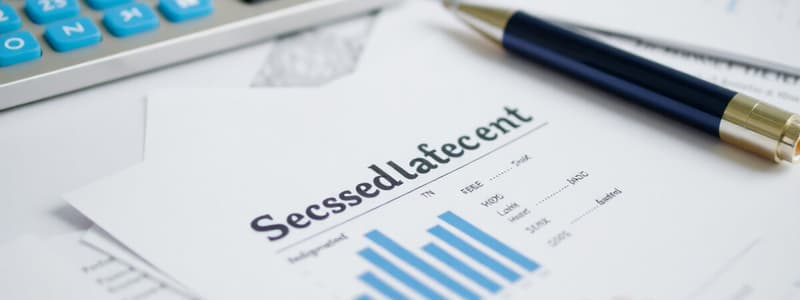Podcast
Questions and Answers
What is the main disadvantage associated with cash accounting?
What is the main disadvantage associated with cash accounting?
- It is more complex than accrual accounting.
- It does not accurately reflect the profitability of a specific time period. (correct)
- It can lead to inaccurate inventory records.
- It makes it difficult to track revenue and expenses.
What is the primary benefit of using the accrual method of accounting?
What is the primary benefit of using the accrual method of accounting?
- It provides a more accurate picture of profitability for a specific time period. (correct)
- It is the most common method used by farmers and ranchers.
- It simplifies record keeping and reduces the need for detailed inventory tracking.
- It is easier to implement than cash accounting.
Which of the following is NOT a question Alex and Mindy should consider when selecting an accounting system?
Which of the following is NOT a question Alex and Mindy should consider when selecting an accounting system?
- What type of inventory management system will they use? (correct)
- What kind of accounting period will they utilize?
- Should they employ cash or accrual accounting?
- Will they use a single-entry or double-entry system?
Which of the following statements regarding accrual accounting is TRUE?
Which of the following statements regarding accrual accounting is TRUE?
What is a potential limitation of accrual accounting?
What is a potential limitation of accrual accounting?
What is the main advantage of using the cash method for recording transactions?
What is the main advantage of using the cash method for recording transactions?
Which accounting system solely focuses on listing receipts and expenses without maintaining a balance between them?
Which accounting system solely focuses on listing receipts and expenses without maintaining a balance between them?
How does the double entry accounting system ensure balance in financial transactions?
How does the double entry accounting system ensure balance in financial transactions?
Why did Alex and Mindy choose to use the single entry accounting system?
Why did Alex and Mindy choose to use the single entry accounting system?
Which of the following is NOT considered an asset account in the context of single-entry accounting?
Which of the following is NOT considered an asset account in the context of single-entry accounting?
What kind of information does a Level 2 record system provide that is important for lenders?
What kind of information does a Level 2 record system provide that is important for lenders?
How does the author illustrate the use of a ledger in single-entry accounting?
How does the author illustrate the use of a ledger in single-entry accounting?
What is the total current assets for Year 2?
What is the total current assets for Year 2?
Which of the following contributes to the total non-current assets for Year 1?
Which of the following contributes to the total non-current assets for Year 1?
What was the total farm liabilities for Year 1?
What was the total farm liabilities for Year 1?
Which asset saw the largest increase from Year 1 to Year 2?
Which asset saw the largest increase from Year 1 to Year 2?
What does the net worth statement reveal?
What does the net worth statement reveal?
What was the increase in farm net worth from Year 1 to Year 2?
What was the increase in farm net worth from Year 1 to Year 2?
Which of the following is a non-current liability?
Which of the following is a non-current liability?
What accounts for both current and non-current farm liabilities combined?
What accounts for both current and non-current farm liabilities combined?
Which category does 'Prepaid Expenses' fall under?
Which category does 'Prepaid Expenses' fall under?
What are current assets in the context of the Kendalls' farm business?
What are current assets in the context of the Kendalls' farm business?
Which of the following are considered current liabilities for the Kendalls' farm?
Which of the following are considered current liabilities for the Kendalls' farm?
What is included in the current assets of the Kendalls' farm?
What is included in the current assets of the Kendalls' farm?
What do non-current liabilities represent in the Kendalls' net worth statement?
What do non-current liabilities represent in the Kendalls' net worth statement?
Which of these items would NOT be classified under current liabilities?
Which of these items would NOT be classified under current liabilities?
What is the definition of a current asset according to the Kendalls' net worth statement?
What is the definition of a current asset according to the Kendalls' net worth statement?
Which of the following statements about current liabilities is true?
Which of the following statements about current liabilities is true?
What happens to current liabilities in the Kendalls' year two net worth statement?
What happens to current liabilities in the Kendalls' year two net worth statement?
What type of items could potentially increase current assets for the Kendalls' farm?
What type of items could potentially increase current assets for the Kendalls' farm?
Flashcards
Accounting Systems
Accounting Systems
Methods for recording financial transactions, including cash or accrual.
Accounting Period
Accounting Period
A specific timeframe for summarizing revenue and expenses, often a year.
Accrual Accounting
Accrual Accounting
Records income and expenses when they occur, regardless of cash movement.
Cash Accounting
Cash Accounting
Signup and view all the flashcards
Single vs. Double Entry
Single vs. Double Entry
Signup and view all the flashcards
Cash Method of Accounting
Cash Method of Accounting
Signup and view all the flashcards
Single Entry Accounting
Single Entry Accounting
Signup and view all the flashcards
Double Entry Accounting
Double Entry Accounting
Signup and view all the flashcards
Expense Ledger
Expense Ledger
Signup and view all the flashcards
Asset Accounts
Asset Accounts
Signup and view all the flashcards
Income Statement
Income Statement
Signup and view all the flashcards
Net Worth Statement
Net Worth Statement
Signup and view all the flashcards
Current Assets
Current Assets
Signup and view all the flashcards
Cash
Cash
Signup and view all the flashcards
Accounts Receivable
Accounts Receivable
Signup and view all the flashcards
Current Liabilities
Current Liabilities
Signup and view all the flashcards
Debt Due
Debt Due
Signup and view all the flashcards
Prepaid Expenses
Prepaid Expenses
Signup and view all the flashcards
Non-Current Assets
Non-Current Assets
Signup and view all the flashcards
Loan Balances
Loan Balances
Signup and view all the flashcards
Investment in Crops
Investment in Crops
Signup and view all the flashcards
Total Assets
Total Assets
Signup and view all the flashcards
Non-Current Liabilities
Non-Current Liabilities
Signup and view all the flashcards
Net Worth
Net Worth
Signup and view all the flashcards
Equity
Equity
Signup and view all the flashcards
Liabilities Plus Net Worth
Liabilities Plus Net Worth
Signup and view all the flashcards
Chart of Accounts
Chart of Accounts
Signup and view all the flashcards
Study Notes
Introduction to Record Keeping
- Without good record keeping, managing a successful business is difficult.
- Accurate records are essential for making sound business decisions.
- Records are a valuable asset for business managers.
- Good record keeping is necessary for complying with tax requirements.
- Records are also crucial for planning and management, including obtaining credit and participating in government programs.
- Records are needed to help determine what to produce.
Kinds of Records
- Chart of Accounts: A set of records providing details for financial statements to analyze farm business health and profitability.
- Includes income and expense ledgers, inventory of current assets, machinery depreciation, loan amortization, and land accounts.
- Net Worth Statement: A snapshot of a business's financial condition at a specific moment. Shows assets, asset values, and liabilities. Also known as a balance sheet or statement of financial position.
- Income Statement: Reflects the profitability of a business over a period, typically a year. Also known as a profit and loss statement or operating statement.
Useful Record Uses
- Assess farm/ranch business financial health
- Evaluate profitability
- Make business decisions
- Secure loans
- Analyze investment opportunities
- Prepare tax returns/manage taxes
Record System
- The Kendalls' (example business) initially used file folders for their records.
- They realized this system was cumbersome and not efficient for making timely business decisions.
- A better system is needed to provide current information on financial and production situations.
- Four-step process to set up a record system:
- Select a suitable record-keeping system
- Select appropriate accounting system
- Determine the method to report income and expenses
- Develop a procedure for retrieving needed information from records
Kinds of Records (cont'd)
- Financial records: Capture receipts, expenses, assets, and liabilities for financial statement creation.
- Physical records: Track production of crops and livestock, as well as input usage (crop yields, percentages of weaned livestock, etc.).
Levels of Record Keeping Systems
- Level 1 (Income Tax Purposes Only): Records are for income tax compliance only, including cash receipts, cash expenses, and depreciation.
- Level 2 (Income Tax Purposes + Business Analysis): Records for tax purposes plus business analysis, including complete inventory and labor/production records.
- Level 3 (Complete Farm/Ranch Analysis): Complete records for all tax and financial statements and detailed enterprise analysis.
Accounting Systems
- Accounting Period: Calendar year (January 1st to December 31st) is most common for farmers and ranchers. A fiscal year could be used if more appropriate.
- Cash vs. Accrual Accounting:
- Cash method records transactions when cash changes hands (received or paid).
- Accrual method records income and expenses when they are earned or incurred, respectively, regardless of when cash changes hands.
- Single vs. Double Entry Accounting:
- Single entry: Records just one side of each transaction.
- Double entry: Records both sides of each transaction to maintain a balance.
Financial Statements
- Net Worth Statement (Balance Sheet): Shows assets, liabilities, and equity (net worth) at a point in time.
- Income Statement: Summarizes revenue and expenses over a period, reflecting profitability. Essential for business analysis and decision-making.
Other Important Records
- Chart of Accounts: Categorizes accounts for financial record keeping.
- Cash Account: Records cash inflows and outflows.
- Accounts Receivable: Tracks amounts owed to the business.
- Accounts Payable: Records amounts owed by the business.
Studying That Suits You
Use AI to generate personalized quizzes and flashcards to suit your learning preferences.




